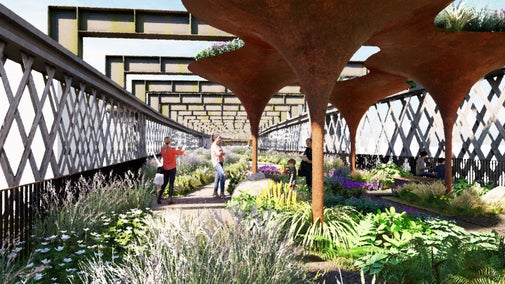Things to see and do at Castlefield Viaduct
- Time to read:
- 7 minutes

Jump to
Ready to explore Manchester’s first garden in the sky? Castlefield Viaduct is open, offering an opportunity to explore the viaduct’s history and experience an urban park in the clouds. Find out more about how to visit and what you can see and do while you're here.
What to expect on your visit
Castlefield Viaduct is open, offering you the opportunity to explore the viaduct and share ideas about the future of this historic structure.
As part of your visit, you’ll discover more about the viaduct’s heritage, as well as exploring an ‘urban garden’ in the sky. Half of the deck has been planted with trees, flowers and shrubs, creating a green space for visitors to unwind in, and learn more about the city’s long relationship with plants and trees.
Visit at your own pace
The viaduct is open for visits from Wednesday – Sunday 10.00am – 5.00pm. Please bear in mind that we have a maximum capacity on the viaduct so there may be a wait if we are busy. Unfortunately we do not allow large items of luggage such as suitcases on the viaduct for safety reasons, thanks for understanding.
Explore a garden in the sky
Creating an accessible green space in the heart of the city is a key part of the viaduct project, and one of our aims is to develop an interesting and nature-filled retreat all year round.
The selection of plants in the viaduct garden has been inspired by the existing vegetation which has claimed this industrial structure, and we’re also trying out new planting techniques, working with limited growing depths and untested growing conditions.
Garden areas to explore
Seasonal highlights in the garden
The viaduct garden has been designed to provide a long season of interest, and the gardening team change the planting on a regular basis to make sure there’s plenty to see throughout the year.
During the summer months, the focus falls on densely planted ferns, grasses and herbaceous perennials. During autumn and winter species like Sorbus and Guelder rose will come to the fore, adding splashes of colour through foliage and berries.
Meet our partner plots
We’ve teamed up with four local partner organisations, who have each created their own unique garden areas on the viaduct. Meet our current partners here:
Sow The City
Working with Hubbub, this is a sensory nature garden complete with a pond – a first for the industrial viaduct. Drawing its inspiration from the latest research in environmental psychology which indicates that the closer an individual’s relationship is with nature, the more likely they are to care for wildlife and the wider environment, the ‘In Our Nature Garden’ garden aims to encourage a connection between people and nature and features wildlife habitats and bee-friendly planting.
City of Trees
City of Trees is a green recovery movement focused on bringing together individuals and organisations to plant trees and restore woodlands for the people and wildlife of Greater Manchester. Their plot highlights ‘Trees that shaped the industrial revolution’, containing trees, shrubs and flowers that were crucial to the development of industry, as well as those that will play a role in the response to climate change.
Castlefield Forum
Castlefield Forum work to protect and promote the Castlefield Conservation Area – preserving and sharing knowledge about the area’s geography, history and culture, and encouraging urban regeneration. Their plot explores the essence of Castlefield within the context of a modern sculptural pocket garden.
Hulme Community Garden Centre
Hulme Community Garden Centre have created an urban forest garden to inspire viaduct visitors to create ‘layered’ planting which optimises precious growing areas, benefitting personal wellbeing and the local environment. The canopy consists of dwarf family fruit trees; a shrub layer of blackcurrant and cranberry; kiwi, hop, and nasturtium climbers; an understorey of edible herbaceous perennials such as rhubarb, globe artichoke and strawberry, plus a selection of self-seeding biennials and annuals.
These edible landscapes stack multiple species within the same space, with each plant taking what it needs from its level in the system to thrive. Once established, these low maintenance gardens produce food, medicines and other beneficial yields, as well as providing an ideal haven for wildlife.

Nature links to the local area
Many of the species you’ll see in the garden have connections to the local area such as cotton grass, Manchester’s county flower, which grows on local moorland and hints at the city’s industrial cotton mill heritage.
The planters separating the partner plots are underplanted with winter flowering hellebores and native ferns, some of which are included in Manchester Museum’s herbarium collections. Elsewhere you’ll find oak trees underplanted with the Red Rose of Lancaster, reflecting the partnership between the National Trust and the people of Manchester.
Visit the events space
This space is used for a range of events, talks and creative sessions – including ‘takeovers’ by our project partners. From apple juice pressing and foraged cocktail making to storytelling events and discussions about nature, there’s lots to learn about at Castlefield Viaduct. Keep an eye on the ‘What’s On’ page for details of upcoming events.
You might also be interested in
History of Castlefield Viaduct
Built in 1892, the Castlefield Viaduct is a core part of Manchester's industrial heritage. Discover more about the area’s history and how the viaduct played a key role in the city’s story.

Our work at Castlefield Viaduct
Learn about the vision for Castlefield Viaduct and about the work we're doing in partnership with Manchester to transform this historic structure into an urban park for people and nature.

Combatting climate change at Castlefield Viaduct
Find out how we’re working to combat climate change at Castlefield Viaduct, as part of a project to transform this historic structure into an urban green space.



